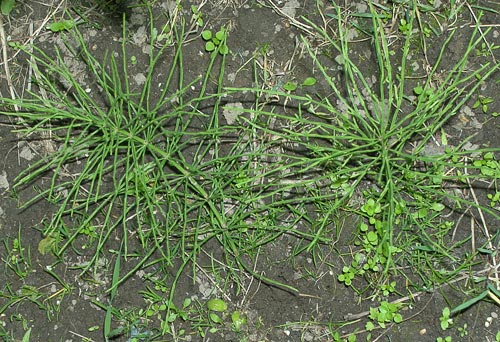Weeds
Equisetum arvense L. - Field Horse-tail
Systematic position.
Family Equisetaceae, genus Equisetum L.Synonyms.
E. arvense subsp. boreale (Bong.) Tolm., E. boreale Bong.Biological group.
This is a perennial rhizome plant.Morphology and biology.
Rhizome entire, dark-brown to black, dull, smooth, slightly pubescent, covered with brown hairs, occasionally bearing tubers; penetrating into the soil to a depth of 1 m and deeper. Main mass of rhizomes is located at a depth of 30-60 cm. Aerial shoots dimorphic or (subsp. boreale) monomorphic, non-wintering; internodes 1.5-4.5 cm. Vegetative shoots 5-50 (-100) cm long, 0.5-4.5 mm thick, green; creeping to ascending (subsp. boreale). Leaf-sheaths are denticulate, triangular, with narrow scarious margin. Branches are in whorls. Strobilus-bearing shoots are not branched, precocious and ephemeral, pale brownish or pinkish, succulent, shorter than the vegetative ones, but with larger leaf-sheaths; withering occurs 10 days after spore dispersal (or withering at apex only in subsp. boreale). Strobili are 7-40 x 4-10 mm; peduncle 22-55 mm, pale. Spores and underground buds produce shoots with the coming of stable warm weather. Pieces of rhizomes and tubercles have high viability, and they can grow from depths down to 50-60 cm. Spores usually disperse in spring or early summer. Hybrids are known between the Field Horse-tail and E. fluviatile and E. palustre.Distribution.
Europe, the Caucasus, the Urals, North-East Siberia, the Himalaya, Central China, Japan, North America; New Zealand (adventive).Ecology.
The species grows in humid meadows with loamy and sandy soils, in fields and kitchen-gardens, pastures, on slopes of irrigation canals and reservoirs. It is an apophytic plant along roadsides and railway- embankment, in sand pits. In steppe zones it inhabits mostly meadows, losing its importance as a weed plant; in forest-tundra and tundra zones it is found rather rarely, selecting dry and sunny slopes of river valleys. The species prefers turf, podzol, and brown forest soils that are variable in density and acidity.Economic significance.
This is a weed plant in all cultures in forest and steppe-forest zones everywhere, littering also rice fields, especially new ones, in the Far East and Middle Asia. It has a high competitive capacity compared with cultivated plants and weeds. Economical threshold is 2-5 plants per sq. m. It causes paralysis of the respiratory center when eaten by animals. Control measures include draining of overly humid and damp soils by laying drainage or open ditches, deep plowing, liming of acidic soils (0.5 t per hectare), bringing organic and mineral fertilizers, potash in particular; replacement of strongly littered (by E. arvense) fields with full fallows (vetch-oat and pea-vetch mixture) having increased seeding rate by 10-15%; deep autumn plowing, spring plowing and sowing of early spring cultures (cutting of the deep root system by use of subsurface tillage causes emaciation of E. arvense); destruction of the Horse-tail stems in uncultivated places (near ditches, railway embankments) by weeding, tilling, stubbling, and mowing.Reference citations:
Bazdyrev G.I., Zotov L.I., Polin V.D. 2004. Weed plants and their control in modern agriculture. Moscow: MSKHA. 288 p. (In Russian)Jonsell, B., ed. 2000. Flora Nordica. V. 1. Lycopodiaceae-Polygonaceae. Stockholm: BTJ AB. 344 p.
Keller B.A., ed. 1934. Weed plants of the USSR. V. 1. Leningrad: AN SSSR. 324 p. (In Russian)
Komarov, V.L., ed. 1934. Flora of the USSR. V. 1. Moscow & Leningrad: AN SSSR. 302 p. (In Russian)
Maltsev A.I. 1937. Atlas of the main weed species of the USSR. V. 1. Moscow & Leningrad: Selkhozgiz. 168 p. (In Russian)
Ramenskii L.G., Tsatsenkin I.A., Chizhikov O.N., Antipin N.A. 1956. Ecological evaluation of the fodder lands by vegetation cover. Moscow: Selkhozgiz. 472 p. (In Russian)
Volkov A.N., ed. 1935. Areas of distribution of the major weed plants in the USSR. Moscow & Leningrad: State Publishing House of Kolkhoz and Sovkhoz Literature. 152 p. (In Russian)


